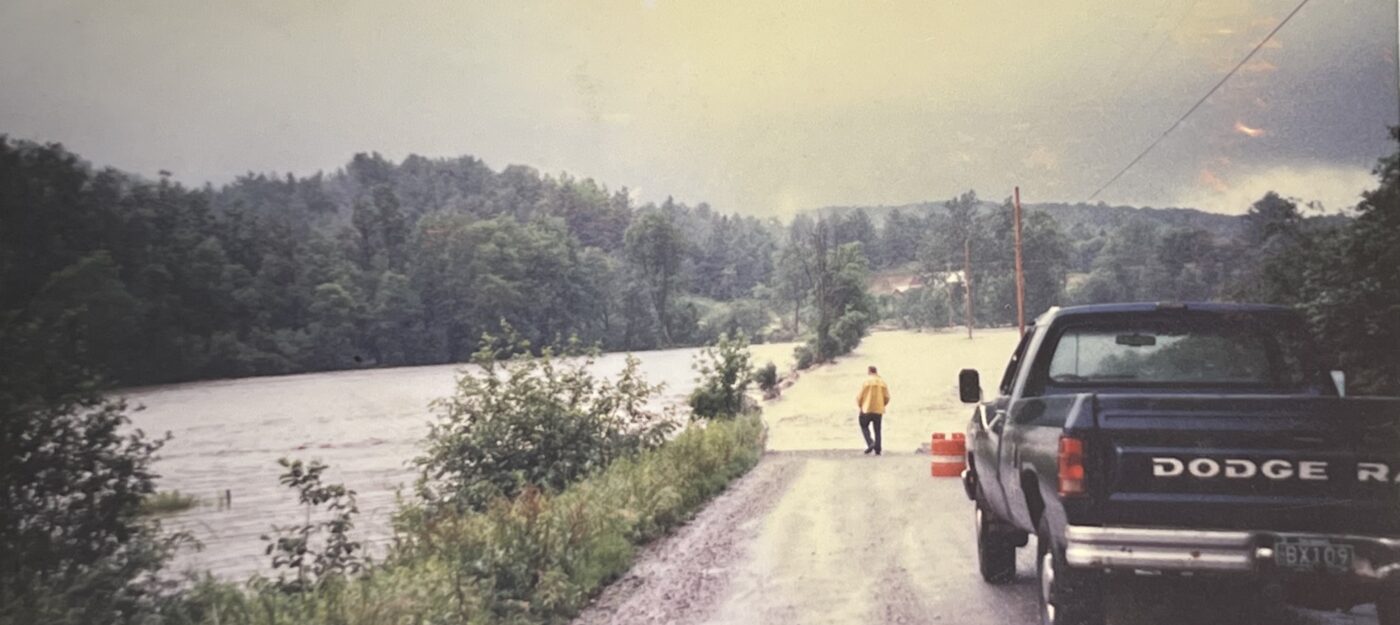This past month, Vermont River Conservancy hosted a webinar with Tim Palmer, an award-winning author and photographer, as part of their 30th Anniversary Virtual River Tours series. Tim presented insights from his book, Seek Higher Ground: The Natural Solution to Our Urgent Flooding Crisis, on flood control challenges in the United States and proposed solutions focused on protecting floodplains and encouraging relocation to higher ground. He discussed the limitations of traditional flood management approaches like damming rivers and building levees, while highlighting successful programs in various states and the cost-effectiveness of relocation compared to flood relief spending. The conversation ended with discussions about floodplain protection efforts in Vermont and upcoming events, including webinars and book discussions. Here are the biggest takeaways from the webinar.

Bolton Potholes, 2024 Flood, Doug Smith.
“Floods happen—they always have.”
In May of 1889, a storm hit Johnstown, Pennsylvania, causing flooding due to the failure of the South Fork Dam. The resulting disaster killed over 2,200 people, destroyed 1,600 homes, and caused an estimated $17 million in property damage. In 1936, heavy winter snowfall, warm temperatures, and heavy rainfall across the northeastern United States caused record-breaking floods. The melting snow and heavy rain overwhelmed rivers like the Connecticut, leading to widespread destruction, deaths, and millions in damages. The severity of the floods led to the passage of the Flood Control Act of 1936, which expanded federal responsibility for flood control projects, such as dams and levees. The Army Corps of Engineers gave early recommendations to Congress: relocate homes out of flood zones. Next, they tried to control nature with dams instead of developing flood resilience plans across affected communities. The New Deal Era laid out new dam projects, but cities were saved at the expense of small rural towns getting flooded due to the location and infrastructure of the dams. Often, levees are used to mitigate floods. However, they often fail due to weak foundations and rising sea levels. Smaller communities often can’t afford to replace outdated or underbuilt levees, and major floods overwhelm levees, especially in the South, when protection matters most. The solution often implemented for disaster recovery is in the form of relief payments. However, short-term monetary support falls short for long-term recovery. Emergency funds cannot support displaced individuals for more than a few weeks, and often, the hardest hit communities lack flood insurance.
Congress’s subsidized flood insurance program still leaves gaps because premiums remain too high for many low-income homeowners, and some high-risk areas are excluded or underinsured.

VT 100 flooded in Granville VT 2023. Katie Strauss.
“Fighting nature is a losing battle.”
As Tim reiterates, fighting nature through damming is not a sustainable solution. Short-term solutions only draw out long-term consequences. “Floods are inevitable and essential to the way nature works.” We need to find solutions where we demonstrate reciprocity for our riparian ecosystems and waterfront forests. Minor floods support the robust root networks, soil systems, and biodiversity by creating groundwater to supplement nutrient cycling. The flows from flooding are natural hydraulic maintenance—fast-moving water creates pools, riffles, and eddies, all important aspects of habitat for many forms of life.
Tim reiterates the necessity to be less reliant on levees, dams, and short-term disaster payments and instead, focus on protecting and restoring natural floodplains. About 7% of U.S. land is floodplain, and 90% of it remains undeveloped—making its preservation a top priority. Protecting these areas from new development helps reduce flood risk, especially for our rural communities, and supports healthy ecosystems. Our second goal should be to encourage relocation to higher ground. Mobility is restricted for many marginalized communities, and people’s ties to their communities make leaving as painful as surviving the flood itself. We can support our community members who hope to seek higher ground in the places they call home through climate mitigation: integrating more parks and greenways in flood-prone communities. These public spaces can double as floodplains—providing recreation, natural flood control, and wildlife habitat. For every dollar we spend on a flood plain, communities will receive up to $13 in some cases in return. Many Southeastern and Southwestern communities have demonstrated success with green infrastructure integration for floodplain restoration, including the Logan Park Stream and Floodplain Restoration at the Chesapeake Bay. Success without dam usage demonstrates that natural restoration methods can prepare for future disasters while contributing to present community well-being.
Tim reflects upon his first flood, when Hurricane Agnes (1972) nearly flooded his home in an Appalachian village. Tim was able to escape the floods, but many people did not, causing an estimated $2.1 billion in damage and a death toll of 128. Through his personal journey and passion for the environment, Tim is committed to advocating for natural flood solutions to better prepare communities, rural and urban, for climate disasters. As the climate continues to warm each year, we have observed an increase in sea level rise and the exacerbation of issues such as changes in rainfall patterns. With heavier than normal rainfall to little to no rainfall, causing extreme drought. This change to our climate has increased the severity of natural disasters like we have seen here in Vermont. Seek Higher Ground outlines the ways communities can be proactive, not just reactive to risks—empowering people to reclaim safety, stability, and hope in the face of a changing climate. As we look to build resilient communities and protect our beloved hometowns in Vermont, we must seek a paradigm shift in how we prepare for floods.
If you are interested in watching Tim Palmer’s presentation on Seek Higher Ground yourself, click the link below for the recording!
